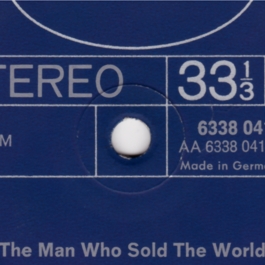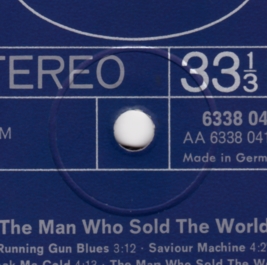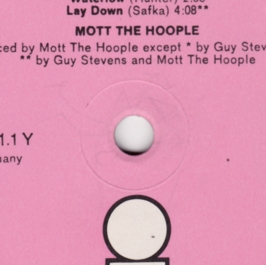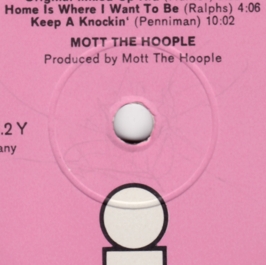The problem
As I already wrote above, it is difficult to detect the release date of German issues of international artists' albums from the late 1960s and early 1970s. So it's not surprising, that it is still unknown when exactly (that is which month) the original German Mercury issue of The Man Who Sold the World was released, but the standard assumption is that record was issued in 1971, like its Australian and UK counterparts. This assumption has been challenged by a strange piece of information I came across on Discogs. Discogs claims that the album was released in 1972, and the reason is given in the description of the record: "Edition with the small pressing ring around the spindle hole, so not pressed and released prior to summer 1972." An official Mercury album by Bowie released in summer 1972? This sounded so absurd to me that I decided to look into this issue a bit more closely, especially because Discogs has become a quite influential website. And I think I can prove that there's no reason to part with the "traditional" view that the album was released in 1971.
Facts
Let's start with a few facts about the record. As pointed out in my entry for the album, there are two different pressings. First, there is an issue with two large centre rings and the following information in the run-out grooves:
- side 1: 10 AA6338041 1Y 320 plus A1 and 1 in different places
- side 2: 10 AA6338041 2Y 320 plus A1 and 1 in different places, plus a faint scratched A4 575 close to the edge of the label
Then there is a pressing with a small centre ring on side 1 and a large ring on side 2. This issue has the following information in the run-out grooves:
- side 1 (small ring): 10 AA6338041 1Y 320 plus a B in a different place
- side 2 (large ring): 10 AA6338041 2Y 320 plus A1 and 1 in two different places


It is not known if the two versions were pressed at the same time (with different machines) or if they were pressed at different times. If the latter is true, then the variant with two large rings probably came first, since white label promo copies have the same label moulding and the same matrix information as these.
However, does the fact that there are copies with small rings mean that they were actually pressed as late as summer 1972?
The legal situation
Let's consider the legal situation. By September 1971 Bowie's contract with Mercury had been terminated, and the deal included that he was given back the rights to his two Philips/Mercury albums. He signed his contract with RCA around the same time. However, it is not exactly clear when the master tapes of the two albums were returned to Bowie/RCA, and some sources claim that Mercury retained the right to keep the master tapes until September 1972. If this is true, then Mercury could have pressed albums in 1972. It is, however, quite unlikely that they did, as the next paragraph will show.
The rarity of Mercury pressings of TMWSTW
The German Mercury pressings of TMWSTW are extremely rare, and so are all four Mercury issues known to be released worldwide. In decades of collecting Bowie records and visiting numerous German record fairs, record stores, jumble sales etc. I've only ever seen a single copy of the album - namely the one I bought. UK issues are equally rare, and Japanese pressings are so rare that the existence of stock copies has only been confirmed in recent years. The only Mercury version of TMWSTW that is not quite so rare is the US issue. At the time of writing (2020) decent original copies (with machine-stamped matrix numbers) can be purchased for about 100 Dollars (which some people would still consider to be a lot of money for a vinyl record). However, the USA is a much bigger market than the other countries in which the album was released, so it's logical that more copies were pressed. Moreover, it always seems to have been the policy of American record labels to press large numbers, and if the records didn't sell, recycle them or delegate them to the bargain bins, so that in many cases the US copies of an album released internationally are among the least rare. So, for a US album of the time the original Mercury issue is very rare!
How could all this be the case if Mercury albums were still pressed in 1972? Bowie's first album on RCA, Hunky Dory, was released in the UK in December 1971, and around the same time or a bit later in many other countries. It was a critical, though not commercial, success. However, it could have triggered the sale of a considerable number of copies of TMWSTW, if
Mercury had pressed them. This argument is even more valid for Ziggy Stardust, released in June 1972: why didn't Mercury press large quantities of TMWSTW if they still had the right to do so? And if Mercury Germany still pressed records in the summer of 1972 (as the Discogs entry claims), why are these records so extremely rare? Quite a few Ziggy fans would have bought them. As of the UK, I've repeatedly read that it was impossible to obtain a Mercury copy of TMWSTW by summer 1972.
All this strongly implies that Mercury actually stopped pressing Bowie album by the end of 1971, and that all Mercury issues of TMWSTW were pressed before 1972. The questions that remains is that of why Bowie's former label insisted on keeping the master tapes for a further year (if that information is correct). I can only speculate on that, but suggest a rather simple answer: they just wanted to make sure that they could sell off all their old stock of the Philips/Mercury albums before RCA could re-issue them.
But what about the centre rings?
Let's return to the original reason for my starting this discussion - the argument that there can't be a German Mercury album with small centre rings pressed before summer 1972. I will show that this is plainly wrong!
First of all, it is not entirely correct that the album has a "small pressing ring around the spindle hole". As I wrote above there are both copies with two large centre rings and copies with a small ring on one side and a large ring on the other. The latter show that small and large rings were produced at the same time.
But still the claim that small rings can't be found before summer 1972 could be correct. However, Mercury wasn't an independent record company at the time but a daughter label of Philips, who made and distributed their records in Germany. So the claim would only be correct if there wasn't any Philips-made record with small centre rings prior to summer 1972. And this is incorrect.
Not only was Philips a label in its own right, but also a major distributor for other labels in Germany in the early 1970s: Vertigo, Charisma and Island (and possibly more) all had their records made and distributed by Philips. This can easily be seen from the Philips-style catalogue numbers: a four digit block always starting with "6" followed by a three digit block, which is in turn followed by a letter (the price code) on the cover (although there are a few exceptions to this pattern).
So to prove the above claim wrong, we must find a Philips-made record that (a) was definitely pressed in 1971 or earlier, and (b) has a small centre ring. And, oddly enough, this is were old Bowie pals Mott the Hoople come into play.
Mott the Hoople's third album Wildlife was originally released on the pink "i" Island label in Germany. The catalogue number was 6339 031 D, so the original pressing was definitely made by Philips. In the course of 1971 (June, according to Discogs) Island changed their German distributor from Philips to Ariola, and the record was quickly re-released on the "pink rim" Island label with a new, Ariola-style catalogue number (86 696 IT). Note that all re-issues and re-pressings of early Island records in Germany were also provided with new Ariola-style numbers. So regardless of wether the change of distributor was actually in June, we can safely assume that all Philips-made copies of Wildlife are pressings from 1971. And the copy of the album shown on Discogs has small centre rings. With respect to the present topic my personal copy is even more interesting: it has a small ring on one side, and a large ring on the other - just like The Man Who Sold the World. So Philips did make records with small centre rings in 1971!


Conclusion
To sum up, then, there are no convincing reasons for 1972 as the year of release of the original German The Man Who Sold the World. On the contrary, there are good reasons to assume that all Mercury pressings of the album, including the German one, were made before 1972.
After all, given the German release policy of the time, any month between April 1971 (month of the UK release) and late 1971 is possible.


 - Informationsplatte Liste Januar 1968 - MU 118-2 (D-or).jpg)
 - Informationsplatte Liste Januar 1968 - MU 118-2 (D-or)-label2.jpg)
.jpg)
-label.jpg)
.jpg)
 - Mercury SR 61246 (US-or)-label.jpg)
-label.jpg)
 (US-or).jpg)
 (US-or)-label.jpg)
-label.jpg)
-unfolded.jpg)
.jpg)
-label.jpg)
